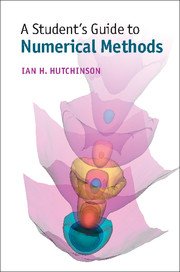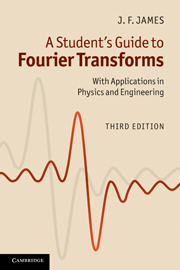A Student's Guide to Numerical Methods
$33.99 ( ) USD
Part of Student's Guides
- Author: Ian H. Hutchinson, Massachusetts Institute of Technology
- Date Published: April 2015
- availability: This ISBN is for an eBook version which is distributed on our behalf by a third party.
- format: Adobe eBook Reader
- isbn: 9781316310533
Find out more about Cambridge eBooks
$
33.99 USD
( )
Adobe eBook Reader
Other available formats:
Paperback, Hardback
Looking for an examination copy?
This title is not currently available for examination. However, if you are interested in the title for your course we can consider offering an examination copy. To register your interest please contact [email protected] providing details of the course you are teaching.
-
This concise, plain-language guide for senior undergraduates and graduate students aims to develop intuition, practical skills and an understanding of the framework of numerical methods for the physical sciences and engineering. It provides accessible self-contained explanations of mathematical principles, avoiding intimidating formal proofs. Worked examples and targeted exercises enable the student to master the realities of using numerical techniques for common needs such as solution of ordinary and partial differential equations, fitting experimental data, and simulation using particle and Monte Carlo methods. Topics are carefully selected and structured to build understanding, and illustrate key principles such as: accuracy, stability, order of convergence, iterative refinement, and computational effort estimation. Enrichment sections and in-depth footnotes form a springboard to more advanced material and provide additional background. Whether used for self-study, or as the basis of an accelerated introductory class, this compact textbook provides a thorough grounding in computational physics and engineering.
Read more- Uses plain language and a conversational style to explain the foundations of numerical techniques
- Includes numerous worked examples and targeted exercises to help students put theories into practice
- Focuses on the heart of physical modelling - the solution of partial differential equations
Customer reviews
Not yet reviewed
Be the first to review
Review was not posted due to profanity
×Product details
- Date Published: April 2015
- format: Adobe eBook Reader
- isbn: 9781316310533
- contains: 73 b/w illus.
- availability: This ISBN is for an eBook version which is distributed on our behalf by a third party.
Table of Contents
Preface
1. Fitting functions to data
2. Ordinary differential equations
3. Two-point boundary conditions
4. Partial differential equations
5. Diffusion: parabolic PDEs
6. Elliptic problems and iterative matrix solution
7. Fluid dynamics and hyperbolic equations
8. Boltzmann's equation and its solution
9. Energy-resolved diffusive transport
10. Atomistic and particle-in-cell simulation
11. Monte Carlo techniques
12. Monte Carlo radiation transport
13. Next steps
Appendix A. Summary of matrix algebra
Index.
Sorry, this resource is locked
Please register or sign in to request access. If you are having problems accessing these resources please email [email protected]
Register Sign in» Proceed
You are now leaving the Cambridge University Press website. Your eBook purchase and download will be completed by our partner www.ebooks.com. Please see the permission section of the www.ebooks.com catalogue page for details of the print & copy limits on our eBooks.
Continue ×Are you sure you want to delete your account?
This cannot be undone.
Thank you for your feedback which will help us improve our service.
If you requested a response, we will make sure to get back to you shortly.
×






